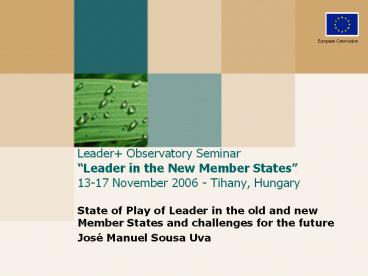Leader Observatory Seminar - PowerPoint PPT Presentation
1 / 9
Title:
Leader Observatory Seminar
Description:
Leader Observatory Seminar 'Leader in the New Member States' 13-17 November 2006 - Tihany, Hungary ... Jos Manuel Sousa Uva. European Commission. Introduction ... – PowerPoint PPT presentation
Number of Views:18
Avg rating:3.0/5.0
Title: Leader Observatory Seminar
1
Leader Observatory Seminar Leader in the New
Member States13-17 November 2006 - Tihany,
Hungary
European Commission
- State of Play of Leader in the old and new Member
States and challenges for the future - José Manuel Sousa Uva
2
Introduction
- Leader has been an incubator for three aspects
- making it possible to advance locally from
dispersed actors and actions to the creation of a
local partnership - allowing the elaboration and implementation of
long term project for a rural community and its
territory - and stimulating local innovation by identifying
and developing new ideas leading to innovative
projects creating local employment.
3
EU 15/EU 10 COMPARISON DIFFERENCES
- Different levels of experience in implementing
the approach - EU 15 3 programming periods (1989-1993,
1994-1999, 2000-2006) - EU 10 one or two years in a few Member States
only (2004-2006) - Different political contexts for the introduction
of the LEADER approachEU 15 - EU 15 Commissions leading role
- EU 10 Optional Member States initiative
4
Experience in the EU 10
- 2004-2006 LEADER type measure implemented within
the Objective 1 Programmes - Option 1 sub-measure Acquisition of Skills in
6 Member States (Czech Rep., Estonia, Hungary,
Latvia, Lithuania, Poland) - Option 2 sub-measure Adoption and
implementation of integrated rural development
strategies of a pilot nature in 3 Member States
(Hungary, Czech Rep. and Lithuania) - No Leader type measure in Cyprus, Malta,
SloveniA and Slovak Republic.
5
Using the past experience of the EU 15
- Twinning programmes, cooperation projects and
networking activities - Importance of capacity building in particular
training of local key players
6
Experience still not usedin the EU 10
- LAG without own legal statute selecting among its
partners an administrative and financial leader -
- Global grant model where the LAG is making
payments to ultimate beneficiaries
7
EU 10 advantages
- Vitality of rural movements supporting the Leader
approach - Better definition of the Leader approach at EU
level
8
Challenges for the future five key
pre-conditions for a good implementation
- Leader axis allowing innovative approaches and
supporting innovative projects - clear rules for the Leader decision making
process where the project selection is made at
local level - proper allocation of responsibilities between the
different levels of government involved - At local level legal statutes of LAGs and
balanced public- private partnerships. - a good management of local development strategy
execution
9
Role of national networks
- Skills acquisition (e.g. training programme for
LAG being established) - Support to cooperation (e.g. cooperation
meetings)































